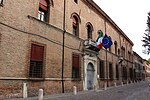Province of Ferrara
Pages with non-numeric formatnum argumentsProvince of FerraraProvinces of Italy

The province of Ferrara (Italian: provincia di Ferrara; Emilian: pruvîncia ad Fràra) is a province in the Italian region of Emilia-Romagna. Its capital is the city of Ferrara. As of May 2023, it has a population of 338,143 inhabitants over an area of 2,635.12 square kilometres (1,017.43 sq mi). The province contains 23 comuni (SG: comune), listed in the list of comuni of the province of Ferrara. Its provincial president is Gianni Michele Padovani.
Excerpt from the Wikipedia article Province of Ferrara (License: CC BY-SA 3.0, Authors, Images).Province of Ferrara
Rampari di Belfiore, Ferrara Borgo Punta
Geographical coordinates (GPS) Address Nearby Places Show on map
Geographical coordinates (GPS)
| Latitude | Longitude |
|---|---|
| N 44.845 ° | E 11.632777777778 ° |
Address
Rampari di Belfiore
Rampari di Belfiore
44123 Ferrara, Borgo Punta
Emilia-Romagna, Italy
Open on Google Maps










